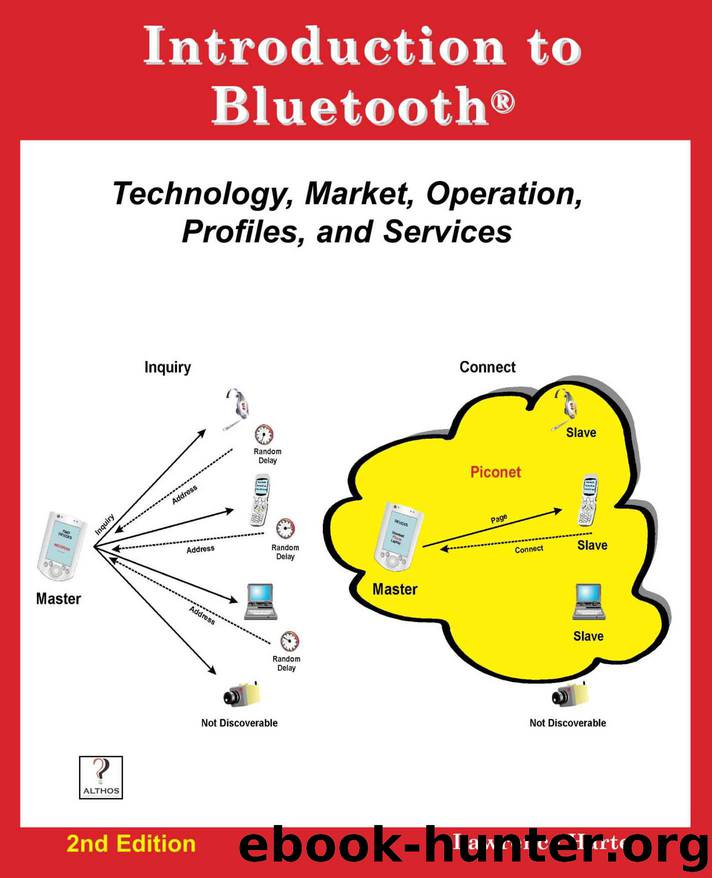Introduction to Bluetooth by Lawrence Harte

Author:Lawrence Harte [Harte, Lawrence]
Language: eng
Format: azw3
Publisher: UNKNOWN
Published: 2017-03-09T05:00:00+00:00
Figure 1.21, Bluetooth Protocol Reference Model
chronous) do not interact with the other protocol layers and directly connect the baseband layer of the device with the upper layer application.
Baseband RF A baseband RF layer is the physical connection (radio) transmission path between two or more points that use the fundamental frequency or transmission components of a communication system. The physical layer performs the conversion of data to a physical medium (radio) transmission and coordinates the transmission and reception of these physical signals.
The baseband layer is responsible for the conversion of data packets into their assigned type of RF packets which contain a header and user data. A packet header is the beginning part of the packet that holds the destination device address and control information. The packet header information in a Bluetooth system usually holds the piconet ID (master address), device ID (number assigned to the slave device), and may include, packet structure type (fields included in the packet), and other packet control related information.
Different types of RF packets hold information in different types of data fields. Asyncrhonous packets contain address and control information and Synchronous packets (time assigned) do not contain address information.
The baseband layer uses the appropriate modulation type (GMSK, QPSK, 8DPSK) to convert the digital bits into an RF signal. The baseband layer senses the received RF power level and controls and adjusts the transmitted RF power level (if RF power control is used).
RF packets may also contain guarded time periods that are not used. Guard time is a time duration that is allocated within a single time slot period in a communication system to help ensure variable amounts of transit times (e.g. from close and distant transmitters) do not cause overlap (collisions) between adjacent time slots.
Figure 1.22 shows that the structure of a Bluetooth RF packet contains the address code of the piconet (local system), device identifier (specific device within the piconet), logical channel identifiers (to identify ports), and a payload of data. If a specific protocol is used (such as a wireless RS-232 communication port - RFCOMM), an additional protocol service multiplexer (PSM) field is used.
Download
This site does not store any files on its server. We only index and link to content provided by other sites. Please contact the content providers to delete copyright contents if any and email us, we'll remove relevant links or contents immediately.
| Automotive | Engineering |
| Transportation |
Whiskies Galore by Ian Buxton(41879)
Introduction to Aircraft Design (Cambridge Aerospace Series) by John P. Fielding(33064)
Small Unmanned Fixed-wing Aircraft Design by Andrew J. Keane Andras Sobester James P. Scanlan & András Sóbester & James P. Scanlan(32743)
Craft Beer for the Homebrewer by Michael Agnew(18140)
Turbulence by E. J. Noyes(7936)
The Complete Stick Figure Physics Tutorials by Allen Sarah(7307)
Kaplan MCAT General Chemistry Review by Kaplan(6867)
The Thirst by Nesbo Jo(6828)
Bad Blood by John Carreyrou(6552)
Modelling of Convective Heat and Mass Transfer in Rotating Flows by Igor V. Shevchuk(6391)
Learning SQL by Alan Beaulieu(6211)
Weapons of Math Destruction by Cathy O'Neil(6146)
Man-made Catastrophes and Risk Information Concealment by Dmitry Chernov & Didier Sornette(5921)
Digital Minimalism by Cal Newport;(5664)
Life 3.0: Being Human in the Age of Artificial Intelligence by Tegmark Max(5474)
iGen by Jean M. Twenge(5366)
Secrets of Antigravity Propulsion: Tesla, UFOs, and Classified Aerospace Technology by Ph.D. Paul A. Laviolette(5309)
Design of Trajectory Optimization Approach for Space Maneuver Vehicle Skip Entry Problems by Runqi Chai & Al Savvaris & Antonios Tsourdos & Senchun Chai(5011)
Pale Blue Dot by Carl Sagan(4912)
